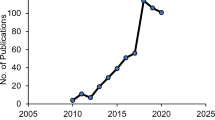Abstract
The tolerance limit for chloride in ordinary Portland cement (OPC) and blended cements such as Portland pozzolana cement (PPC) and Portland slag cement (PSC) was assessed by cyclic polarisation. This study covers both cement extracts and mortar. The salient features of this investigation were: in extracts, the tolerance limit for chloride actually doubles for PSC when compared to PPC and OPC. The tolerance limit for chloride for various mortars follows the order: PSC > PPC > OPC. In OPC and PPC mortar, the repassivation potential (E rep) shifted negatively with higher amounts of free chloride but in PSC mortar E rep shifted positively (+590 mV) even in the presence of 5,000 ppm of free chloride. PSC takes longer time (50 days) to reach E rep indicating perfect passivity maintained for the embedded steel.





Similar content being viewed by others
Abbreviations
- OPC:
-
Ordinary Portland cement
- PPC:
-
Portland pozzolana cement
- PSC:
-
Portland slag cement
- OCP:
-
Open circuit potential
- TMT:
-
Thermomechanically treated
- SCE:
-
Saturated calomel electrode
- E rep :
-
Repassivation potential
References
Haque MN, Kayyali OA (1995) Cem Concr Res 25:531
Sayed HAE (1986) Corros Prev Control 33:92
Tuutti CK (1982) In: Corrosion of steel in concrete. Swedish Cement and Concrete Research Institute, Stockholm, p 238
Erlin B, Verbeck JG (1975) In: Pepper L, Pike RG, Willet JA (eds) Corrosion of metals in concrete, ACI SP-49 Detroit, p 39
Patel C (1981) Corros Sci 21:145
Alonso C, Castellote M, Andrade C (2002) Electrochim Acta 47:3469
Mahallati E, Saremi M (2006) Cem Concr Res 36:1324
Martín-Pérez B, Zibara H, Hooton RD, Thomas MDA (2000) Cem Concr Res 30:1215
Gowripalan N, Mohamed HM (1998) Cem Concr Res 28:1119
Basheer PAM, Andrews RJ, Robinson DJ, Long AE (2005) NDT & E Int 38:219
Thangavel K, Rengaswamy NS (1998) Cem Concr Compo 20:283
Chindaprasirt P, Rukzon S (2007) Const Build Mater. doi:10.1016/j.conbuildmat.2007.06.010
Ha TH, Muralidharan S, Bae JH, Ha YC, Lee HG, Park KW, Kim DK (2007) Build Environ 42:78
Wilsch G, Weritz F, Schaurich D, Wiggenhauser H (2005) Const Build Mater 19:724
Proverbio E, Carassiti F (1997) Cem Concr Res 27:1213
Shin CB, Kim EK (2002) Cem Concr Res 32:757
Arora P, Popov BN, Haran B, Ramasubramanian M, Popova S, White RE (1997) Corros Sci 39:739
Ann KY, Song HW (2007) Corros Sci 49:4113
Gabrielli C, Joiret S, Keddam M, Perrot H, Portail N, Rousseau P, Vivier V (2007) Electrochim Acta 52:7706
Manera M, Vennesland O, Bertolini L (2007) Corros Sci. doi:10.1016/j.corsci.2007.07.007
Izquierdo D, Alonso C, Andrade C, Castellote M (2004) Electrochim Acta 49:2731
Thangavel K, Balasubramanian TM, Rengaswamy NS (2000) Indian Concr J 74:203
Acknowledgements
The authors thank the Director, CECRI, Karaikudi for kind permission to publish this article. The authors also gratefully acknowledge the support from a Center for Concrete Corea, South Korea for financial assistance.
Open Access
This article is distributed under the terms of the Creative Commons Attribution Noncommercial License which permits any noncommercial use, distribution, and reproduction in any medium, provided the original author(s) and source are credited.
Author information
Authors and Affiliations
Corresponding author
Rights and permissions
About this article
Cite this article
Song, HW., Saraswathy, V., Muralidharan, S. et al. Tolerance limit of chloride for steel in blended cement mortar using the cyclic polarisation technique. J Appl Electrochem 38, 445–450 (2008). https://doi.org/10.1007/s10800-007-9457-3
Received:
Revised:
Accepted:
Published:
Issue Date:
DOI: https://doi.org/10.1007/s10800-007-9457-3




